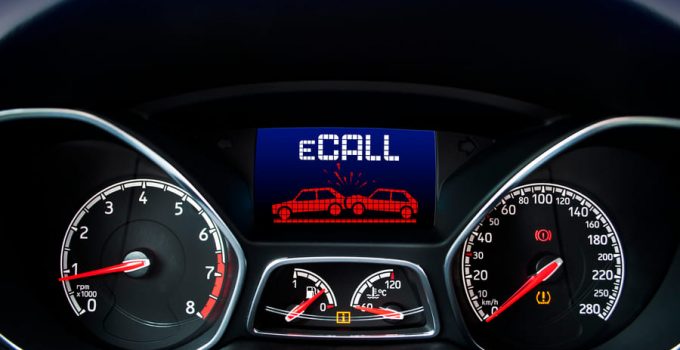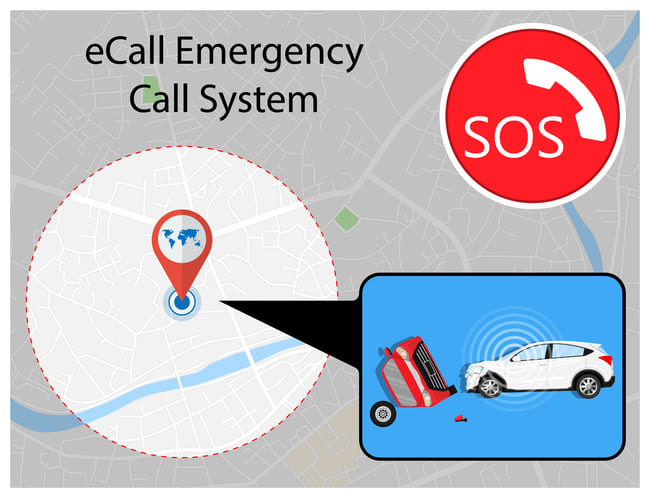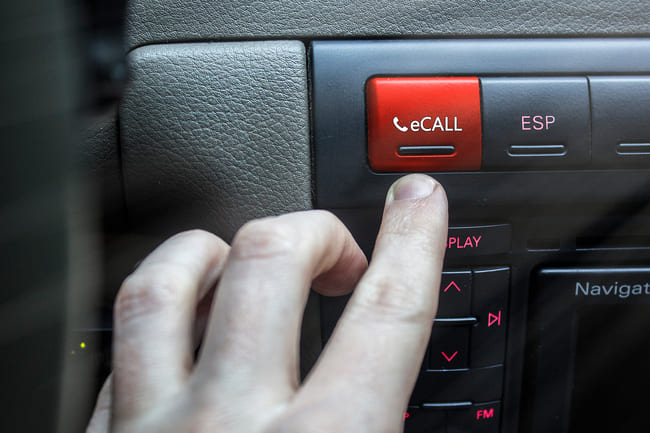
Setting up the automatic emergency call system Emergency Call, also known as eCall, became mandatory in The United Kingdom and in all EU member states from March 31, 2018. In the event of an accident, the eCall system automatically calls the emergency services and sends important information to the relevant rescue control center so that help can be provided quickly in the best of cases. The big advantage of this car emergency call system is that the rescue service is alerted immediately without the driver having to do anything, so there are no communication difficulties, which is a big plus, especially when traveling abroad. But even more important: In the event of a serious car accident, every second counts. According to the EU Commission, thanks to this facility, emergency services can reach the scene of an accident up to half the time it would take if they were called independently. However, the signal can also be triggered manually using the SOS button in the car, for example if the rescue service is required for one of the passengers for medical reasons. When it comes to security, this emergency call system remains unsurpassed.
Contents
How exactly does the automatic emergency call system work?

Vehicles equipped with this system have so-called crash sensors that react to an impact. If the airbag is deployed, which usually happens in a serious collision, the eCall emergency call system will automatically kick in. However, other components of the passive safety system also play a role in this context. For example, the system can register how many occupants are in the vehicle if they are wearing seat belts.
If the device is then activated, you can speak to the emergency services yourself through a hands-free system. However, the system is also capable of contacting the emergency call center without the occupants having to do anything. It runs on an emergency power supply so that the necessary safety is still guaranteed even in the event of a broken car battery. The emergency call is of course free of charge for everyone affected. The relevant manufacturers ensure that the vehicle models are correctly equipped: crash sensors, intercoms, GPS receivers and antennas are part of the standard equipment of the eCall system. So basically it goes like this:
- Accident: A severe impact is detected by the sensors, whereupon a connection to the emergency call center is established
- Message: Important data is sent to which transmits 112 in order to be able to guarantee life-saving measures in the worst case: Exact vehicle position, number of occupants, time of the accident, direction of travel
- Rescue measures: Emergency doctor, fire brigade and police go to the scene of the accident immediately
Which data is actually transmitted when the system is activated?
If the occupants do not respond, the system sends information on the vehicle's position, the time of the accident, the direction of travel, the number of passengers, as well as data on the vehicle type and how the assistant was triggered. To be able to do this, it must have a receiver for GPS and Galileo location data. The fear that the emergency call assistant could also be triggered in the event of minor breakdowns when parking or in other minor situations is unfounded: it does not sound an alarm here. Should this be the case, the manufacturer should be contacted urgently, or the device should be examined in the workshop. With regard to data protection, only the points mentioned above are sent to the rescue service control center and this and other data are not recorded. According to the ADAC, the data may only be recorded in an emergency, so that no movement profiles can be created. Under no circumstances should you deactivate the system: it is part of the infotainment system, just like the radio, navigation system and hands-free system and can normally not be switched at all. If eCall is deactivated at the time of an accident, there can also be significant problems with the insurance afterwards – the insurance cover is then lost because the vehicle should no longer have been on the road.
Can eCall also be retrofitted?
Yes, the automatic emergency call system can certainly be retrofitted. Older vehicles are generally exempt from the obligation, but it is still advisable to retrofit the eCall system. So which cars have eCall? On the other hand, vehicle models that are new to the market in the European Union must be equipped with this device. However, this does not mean that every new car that is purchased automatically has such a system integrated. Only new model series are affected by the eCall regulation. The cost of retrofitting sometimes depends on the vehicle model. It remains questionable whether older vehicles would actually have all the functions of the on-board systems after retrofitting. But there are also other ways to make driving safer: An accident reporting connector equipped with crash sensors can be connected to the vehicle via a smartphone app, so that the emergency call can be sent via the app itself. Here, too, a voice connection is first established – and if no one can be reached, the emergency call center is automatically contacted. The emergency call app is mostly offered by car insurers; Depending on the insurance, the costs can amount to around 10 euros a year.
Why is the eCall system so important?

EU Regulation 2015/758 obliges vehicle manufacturers to equip new vehicles with the Emergency Call system, and not without reason: in the worst case, the accident victim is threatened with serious physical damage, the consequences of which could have been avoided if the rescue service had been at the scene of the accident early. One hour – the journey to the scene of the accident, the first aid on site and the way to the clinic shouldn’t take more time. In this context one speaks of the so-called Golden Hour of Shock. Politicians assume that this will not be exceeded with an emergency call assistant and that on average around 2000 lives can be saved each year. A few minutes often make the difference between serious and minor consequences, sometimes even life and death. You don't always have to assume the worst, but in an emergency the emergency call assistant can save lives. Therefore, there is no reason why this precautionary measure should not also be taken afterwards. A clear conclusion: With a retrofitted eCall system you are on the right side and contribute to increasing not only your own safety but also that of your passengers.
